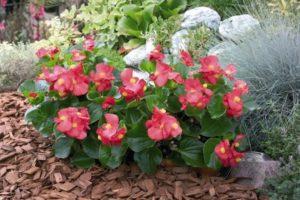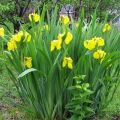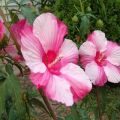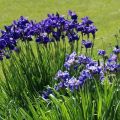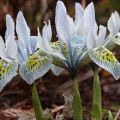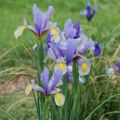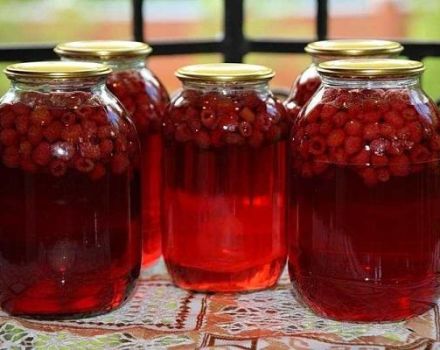Description of marsh iris, planting, cultivation and care in the open field
In nature, you can find plants with yellow flowers on the banks of water bodies, similar to a garden killer whale. This type of iris is called marsh iris for its ability to develop, multiply in water. Now the plant is cultivated in their gardens by summer residents, using the beneficial properties of a representative of the Kasatikov family.
Marsh iris: description and characteristics of the plant
The herbaceous perennial grows successfully in water. Its rhizomes develop well in the aquatic environment, accumulating nutrients. The growth point is located at the side of the roots, so the lateral shoots are deflected in different directions. They grow horizontally, filling the free space. Leaves and flowers are formed from the buds on the rhizome.
The leaves of the xiphoid type of iris are light green or variegated in color. Together with the stem, they can be 2 meters long.
Buds are located on high peduncles. There can be up to 12-15 of them on branched stems. There are 3 petals in the outer and inner circle. In addition to the yellow color with an orange spot in the middle, they are blue, white.
After the flowers fall in mid-July, their seed box is formed in place. As it ripens, the fruit throws the seeds into the water. This is how the aquatic species of iris reproduces in nature.
Outwardly, the plant resembles marsh calamus, hence the second name for its iris calamus.
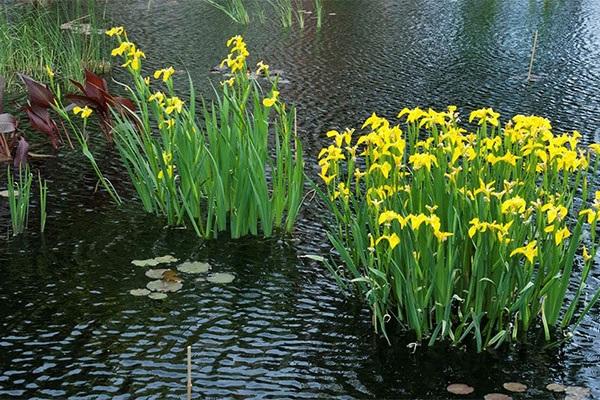
In addition, the flower belongs to medicinal plants. Its rhizomes are used for coughs, migraines, sore throats, gastritis. Iris leaves are rich in ascorbic acid, amino acids.
The nuances of growing outdoors
For summer residents with marshy ground in areas, marsh iris will be a real find. It takes root quickly and is easy to care for. Choosing the right varieties of the species, you can decorate them with a pond.

The choice of planting material
It is better to plant calamus iris with seeds. To do this, you only need to deepen the seeds floating on the surface of the water from the cultivated plant. There is no need to process the seed, it takes root well and sprouts.
The rhizome for planting is selected with a bud. Shoots will go from it. Before planting, the roots are examined, freeing from damaged and rotten parts. You can treat the rhizomes with a solution of potassium permanganate.
Soil preparation
To grow, marsh iris needs an open, sunny place, protected from the winds. It grows well in the shade. Pay attention to the fact that the soil is highly moist.On dry sandy plants, the plant will die. You can pick up a site in a reservoir where it is shallow. The acidity of the soil for flowers should be within 7.0. Do not forget about the nutritional value of the soil, fertilizing it with organic substances.

Landing scheme
Plants planted in August-September take root best of all. A hole is prepared for planting flowers with a depth and width of 40-60 centimeters. It is necessary not to plant irises close to each other. Growing up, they can crush neighbors. The gap is 80-100 centimeters. Over time, the plants form beautiful decorative groups.
In order for irises to bloom brightly and for a long time, plantings are mulched with peat or humus.
The specifics of plant care
Swamp iris care is standard. For him, moisture and nutrition are important. Otherwise, there are no special requirements for care.

Lighting
For marsh iris, unlike other relatives, not much sun is needed. In lighted places, the flowering of the decorative culture will be brighter. But the flower also withstands partial shade well. Therefore, it can be planted on the banks of a pond near trees.
Top dressing
If the rhizomes are planted in a soil rich in organic matter, then at first it is not necessary to feed the flowers. Before flowering, when the buds appear in May, phosphorus and potassium fertilizers must be applied. You can replace them with wood ash. It is buried in moist soil next to the plant stems. Take 500 grams of fertilizer per square meter.
Watering
If irises grow in water or near a body of water, it is not necessary to water them. But plants planted on the site require abundant moisture. They constantly make sure that the earth does not dry out.

Preparing for winter
The horizontal arrangement of the root system of irises needs shelter for the winter. It is necessary to sprinkle the planting with a layer of peat, humus 10 centimeters. Can be covered with straw on top. Remember to feed the plants in the fall so they get through the winter well.
How to deal with diseases and pests
Diseases are rare in the calamus iris. Mold may appear on the roots. But then you need to transplant the plants to another place, and disinfect the soil.
Of the pests, gladiolus thrips affects flowers. Brown-colored insects measuring 1.5 centimeters fly from plant to plant. Climbing into buds, insects and their larvae damage peduncles. The buds look burnt, do not open, dry out. Suffer from thrips and corms.
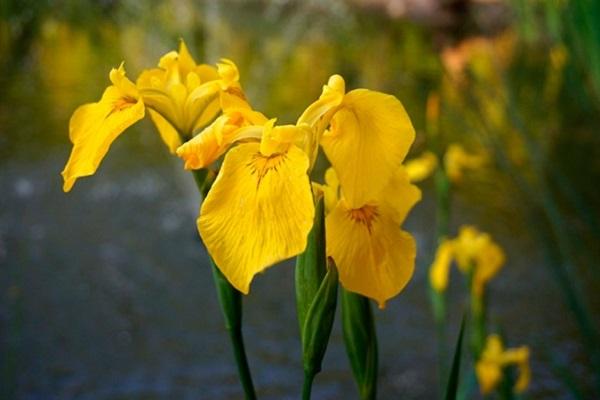
To combat thrips, iris bulbs are discarded before planting. Healthy ones are pickled in a solution of "Karbofos". Insects are fought by spraying plantings with insecticidal preparations in dry weather.
Reproduction
You can choose for reproduction of irises both seed and vegetative way. Seeds are harvested at the end of summer and dried. You can sow them in winter or spring. Seedlings will appear quickly. But the plant will bloom only in the 3-4th year.

Rhizome division is the most common breeding method for marsh irises. They are harvested after the plants have faded. It is necessary to cut the material with the kidneys. It is washed, damaged parts are removed. You can store it in the refrigerator or cellar. They are planted in the spring at a selected and prepared place.
Use in landscape design
Designers love yellow and blue iris for their unpretentiousness and decorativeness. Where garden flower species grow poorly, marsh iris will take root. It is planted in flower beds, decorated in the lowlands. It goes well with annuals. By choosing flowers by color, you can revive them with blue and yellow varieties of culture.
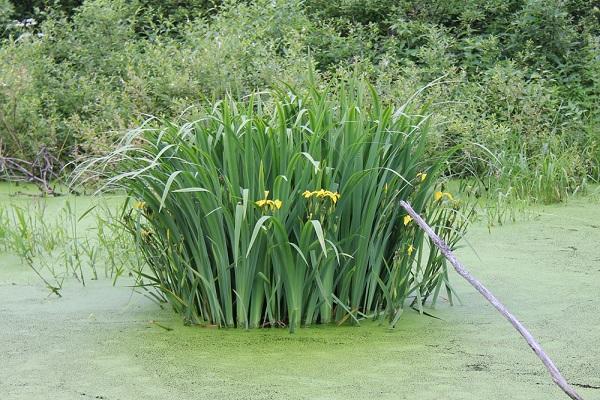
Calamus irises look good in water, near an artificial or natural pond. Their tall stems can be combined with thickets of berry and juniper.
The bright inflorescences of the plant in the form of a hedge, on the border of the zones of the site, are pleasing to the eye.
